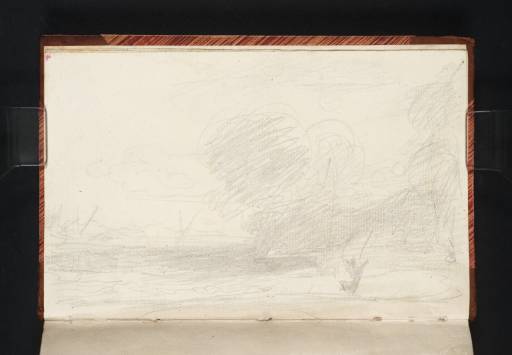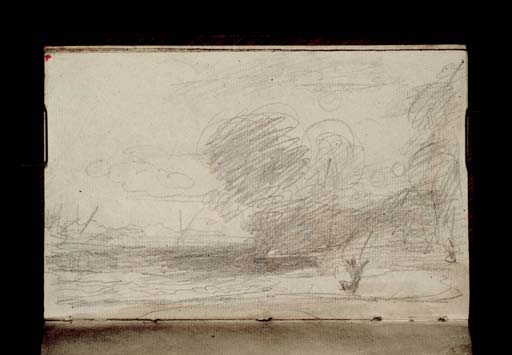Joseph Mallord William Turner Chryses 1805
Image 1 of 2
Joseph Mallord William Turner,
Chryses
1805
Joseph Mallord William Turner 1775–1851
Folio 3 Verso:
Chryses 1805
D06184
Turner Bequest XCVIII 3a
Turner Bequest XCVIII 3a
Pencil on white laid paper, 117 x 182 mm
Accepted by the nation as part of the Turner Bequest 1856
Exhibition history
1990
Painting and Poetry: Turner’s ‘Verse Book’ and his Work of 1804–1812, Tate Gallery, London, June–September 1990 (28).
References
1909
A.J. Finberg, A Complete Inventory of the Drawings of the Turner Bequest, London 1909, vol.I, p.253, XCVIII 3a, as ‘Study for picture of “Chryses”’.
1974
Gerald Wilkinson, The Sketches of Turner, R.A. 1802–20: Genius of the Romantic, London 1974, p.83 reproduced in colour.
1977
Gerald Wilkinson, Turner Sketches 1789–1820, London 1977, p.121 reproduced in colour.
1990
Kathleen Nicholson, Turner’s Classical Landscapes: Myth and Meaning, Princeton 1990, pp.268, 272.
1990
Andrew Wilton and Rosalind Mallord Turner, Painting and Poetry: Turner’s ‘Verse Book’ and his Work of 1804–1812, exhibition catalogue, Tate Gallery, London 1990, p.125.
1993
David Hill, Turner on the Thames: River Journeys in the Year 1805, New Haven and London 1993, pp.64, 167, as ‘A robed figure on a Mediterranean shore, with the setting or rising sun seen in various positions’.
2001
Robert Yardley, ‘Chryses’, in Evelyn Joll, Martin Butlin and Luke Herrmann eds., The Oxford Companion to J.M.W. Turner, Oxford 2001, p.43.
For the story of the Trojan priest Chryses, told in Book 1 of Homer’s Iliad, see catalogue notes to early versions of this composition in the contemporary Studies for Pictures: Isleworth sketchbook (Tate D05588, D05597; Turner Bequest XC 61a, 69) and another leaf in the same book (Tate D05541; Turner Bequest XC 34). Also in the book are notes citing other moments in the story of the priest and his daughter Chryseis.
Here, Turner has elaborated his initial ideas in pencil. The priest stands on the shore, invoking the sun-god Apollo to punish the Greeks, who have captured his daughter, and aid her return. On folio 4 (D06185) he repeats the composition more broadly in ink and wash, a little of which has passed across the gutter of the book onto the present drawing. A further, similar version of the subject is on folio 5 verso (D06187). As Hill observes, this last is closest to the watercolour Chryses (private collection),1 exhibited at the Royal Academy in 1811 with lines from Turner’s immediate source, Alexander Pope’s translation of the Iliad. In this passage, Pope describes the priest walking the shore as seen in the earlier studies – ‘Silent he wander’d by the sounding main’ – and praying to the god as Turner shows him, kneeling, in the exhibited watercolour.
Wilton remarks that the composition studies in this sketchbook, by creating a ‘framework for the action of pure light’, anticipate the ‘all-pervasive warmth and brilliance of Mediterranean light’ that Turner achieved in the watercolour where it suggests the presence of Apollo. Wilton links this treatment of natural phenomena as co-protagonists in the story with Turner’s ideas on Ulysses and Polyphemus, set out in a study on folio 5 (D06186).2
David Blayney Brown
July 2008
How to cite
David Blayney Brown, ‘Chryses 1805 by Joseph Mallord William Turner’, catalogue entry, July 2008, in David Blayney Brown (ed.), J.M.W. Turner: Sketchbooks, Drawings and Watercolours, Tate Research Publication, December 2012, https://www


